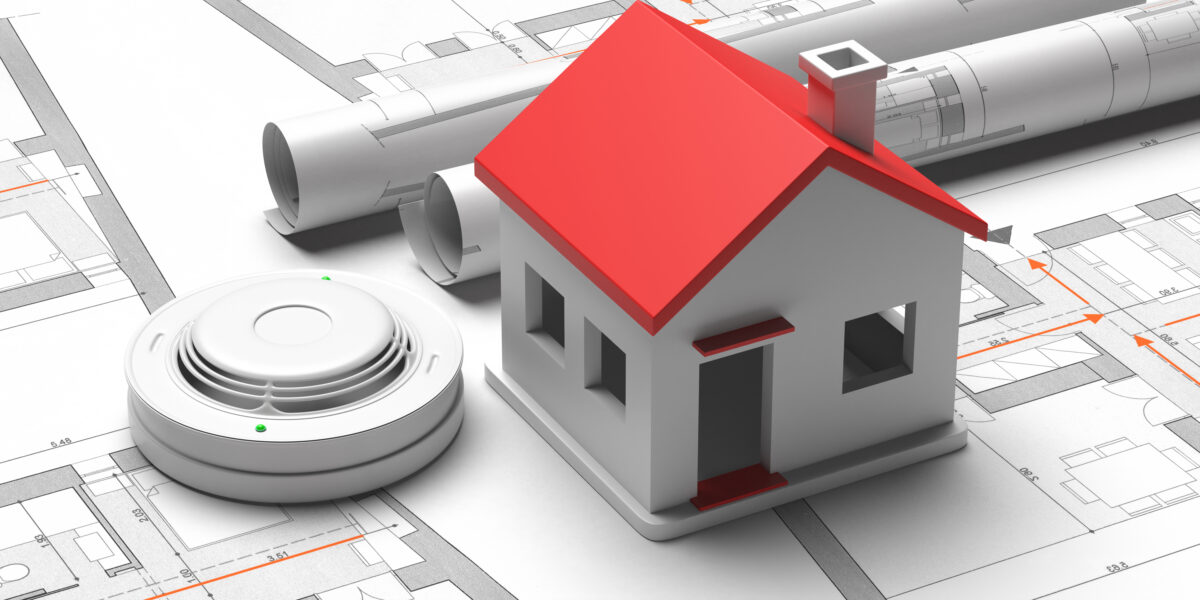How Many Smoke Detectors Do I Need?

The soft chirp of a smoke detector is more than just a background noise; it’s a life-saving tool. Smoke detectors are indispensable in safeguarding our homes from potential fire hazards. The number of smoke detectors one needs primarily depends on the size and layout of the residence.
The Basics of Smoke Detectors:
At its core, a smoke detector is a device that senses smoke, typically an indicator of fire. There are primarily two types of smoke detectors:
- Photoelectric: These respond more quickly to smoldering fires by detecting the larger particles released by such fires.
- Ionization: These are faster at detecting flaming fires as they identify smaller particles.
Despite their differences, both types detect the presence of smoke. When smoke enters the detector chamber, it interrupts a path of light or electrical current, triggering the alarm.
Reasons for Having the Right Number of Smoke Detectors:
Ensuring that your home has adequate smoke detectors isn’t merely adhering to safety protocols—it’s a proactive approach to safeguarding what matters most.
- Increased Safety and Protection: More detectors mean a higher chance of early detection, which can be the difference between a minor incident and a major disaster.
- Faster Response Time in Emergencies: With detectors installed throughout a home, fires can be detected quicker, allowing for a swift evacuation.
- Minimize Property Damage: Early detection gives the occupants a better chance to extinguish the fire before it can cause significant damage.
- Peace of Mind for Occupants: Knowing that every corner of your home is under the vigilant watch of a smoke detector brings a profound sense of security.
National Fire Protection Association (NFPA) Guidelines:
The NFPA, a recognized authority on fire safety, has set forth guidelines that every homeowner should be acquainted with. Their recommendations, grounded in thorough research and expertise, provide a robust framework for smoke detector placement.
- Detectors in Every Sleeping Room: Since fires can occur at night when everyone is asleep, having a smoke detector in every bedroom is paramount for early detection.
- Detectors Outside Each Sleeping Area: Install detectors in the hallways or common areas outside bedrooms to maximize protection. This ensures that smoke is detected even before it reaches someone sleeping.
- One Detector on Every Level: From the basement to the attic, every level of a home should be equipped with at least one smoke detector. This ensures holistic protection against fires that might start on any floor.
- Larger Homes Need More: If your home has vast square footage, you might need more detectors than the average-sized home to cover every nook and cranny.
Factors to Consider When Determining Quantity:
Determining your home’s exact number of smoke detectors requires a more granular approach.
- Size Matters: A larger home naturally requires more detectors to cover its expanse effectively.
- Multiple Floors: Homes with numerous stories or levels warrant a detector on each floor.
- Room Count and Layout: An open-concept living area might need fewer detectors than a home segmented into many rooms.
- High-Risk Areas: Kitchens, garages, and basements, being prone to fires, should always have detectors. In kitchens, it’s best to install them away from cooking appliances to avoid false alarms.
- Architectural Features: Homes with vaulted ceilings, atriums, or unique architectural elements may require additional considerations to ensure effective smoke detection.
Proper Placement of Smoke Detectors:
Placing them correctly is crucial once you’ve determined how many detectors you need.
- Ceiling vs. Wall: Smoke rises. Thus, ceilings are the best spot for your detectors. If placing on a wall, ensure it’s close to the ceiling but not in the “dead air” space where walls and ceilings meet.
- Close to Fire Sources: Areas with potential fire hazards, like fireplaces or stoves (though not too close to avoid false alarms), should have a nearby detector.
- Avoiding False Alarms: Ensure detectors are away from windows, vents, or cooking areas that might trigger them unnecessarily.
- Interconnected Alarms: Modern homes often come with interconnected smoke alarms. When one detector is triggered, all alarms in the house sound off, ensuring quick evacuation.
Special Considerations:
When contemplating the number and type of smoke detectors, special considerations should be considered.
- Smoke Detectors for the Hearing Impaired: Traditional smoke detectors rely on auditory alarms, which may not be effective for people who are hard of hearing. However, specialized detectors equipped with strobe lights and bed shakers are available. These devices offer a tactile or visual alert, ensuring that those with hearing difficulties are alerted promptly in case of smoke detection.
- Integration with Home Security Systems: Modern homes often feature integrated security systems encompassing intrusion detection, fire alarms, and more. When a smoke detector is integrated into such a system, the central unit can alert the homeowner via phone or app and even notify the fire department automatically, enhancing response times.
- Smart Smoke Detectors: Smart home devices now include smoke detectors that offer various benefits. They can send alerts to your phone, be silenced from your device, and even inform you which room the smoke is coming from. Some models can differentiate between types of fires, offering a more nuanced response.
- Lifespan of a Smoke Detector: Like all electronic devices, smoke detectors have a finite lifespan. On average, they should be replaced every ten years. Moreover, if your detector frequently gives false alarms or doesn’t respond to tests, it may be a sign to replace it sooner.
Maintenance and Testing:
Owning a smoke detector isn’t a ‘set it and forget it’ scenario. Regular maintenance ensures they function correctly when you need them the most.
- Regularly Testing Your Smoke Detector: Every smoke detector has a test button. Testing your device at least once a month is recommended to ensure it’s operational.
- Replacing Batteries: Even if you don’t hear the low-battery chirp, replacing smoke detector batteries at least once a year is a good practice. For those with 10-year lithium batteries, replace the entire unit when the battery runs out.
- Cleaning and Dusting: Dust and debris can interfere with a detector’s operation. Gently vacuum around or over the detector regularly. Some models may also benefit from a light dusting.
- Replacing Outdated or Malfunctioning Detectors: Don’t compromise on safety. If a smoke detector is not working optimally, replace it. Keep in mind the 10-year lifespan and use it as a guide.
Conclusion:
There’s no overstating the significance of having the correct number of functional smoke detectors in your home. These unassuming devices guard our homes, offering an early warning system that can save lives and minimize property damage.
But simply having them isn’t enough. Like any tool, they require maintenance to perform optimally. Set reminders for regular testing, battery replacement, and device cleaning. Stay updated about the latest smoke detection technology; when the time comes, replace outdated units without hesitation.
Your home is not just bricks and beams; it’s memories, moments, and the people you love. So, take a moment to assess your home’s needs, ensuring a vigilant smoke detector shields every corner. Safety is more than just a precaution; it’s a commitment to the well-being of those we cherish.







